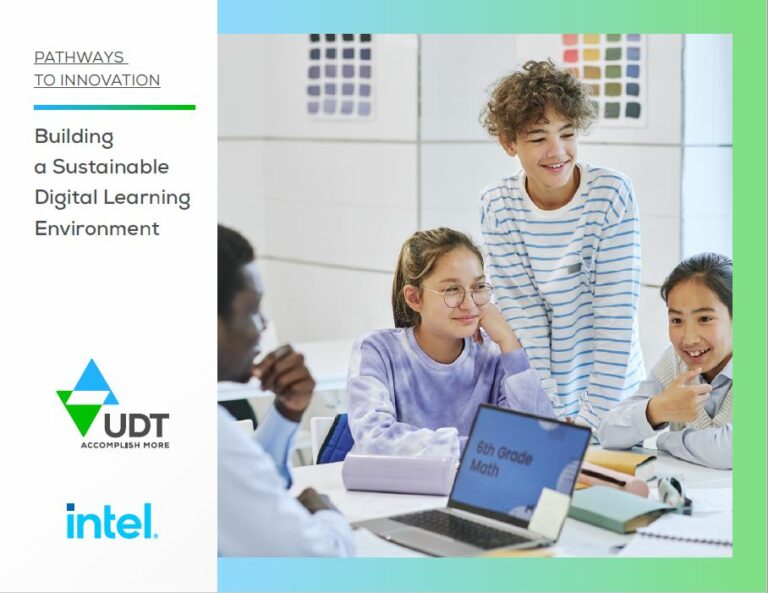In the rapidly evolving landscape of Education Technology, it is crucial to think about your one-to-one (1:1) device strategy in a manner that links every student, teacher, and administrator experience with its own device specifications. This persona-based approach is critical for strategic planning. The rapid innovation of hardware as well as paradigm-shifting technologies like artificial intelligence (AI) make futureproofing your endpoint investments a key consideration.
Moreover, the integration of educational apps into the curriculum can significantly enhance the learning environment. These apps, tailored to the needs of elementary school students through high school students, can provide interactive and engaging content, fostering a more dynamic and immersive learning experience. In this context, it’s important to note that the selection of educational apps should be done with careful consideration. The apps should be age-appropriate, aligned with the curriculum, compliant with student data privacy policies, and should promote critical thinking and problem-solving skills. You should also ensure the hardware you choose for specific student groups can support the requirements of critical apps.
Unlock your pathway to innovation with our guide.
Building 1:1 digital learning environments is a complex journey. To help you achieve the best outcomes, UDT & Intel have collaborated to gather key insights from seasoned CIOs, CTOs, educational leaders, and educators. Here’s what you’ll gain:
- Personalized workbook to help you identify target areas to improve your 1:1 programs
- A student-centered, decision-making Framework covering 6 key focus areas
- A self-assessment to guide your journey
- Details on how to create your custom action plan
- And more!
Download your free copy now to start developing your personalized action plan.
How 1:1 Device Programs Empower Students and Educators
Equipping students and educators with the right devices—coupled with high-speed Internet access—K12 schools can empower effective learning and professional development opportunities optimized to unlock their full potential for success. Developing a robust 1:1 device program involves maximizing the impact of digital learning experiences. You should set ambitious goals that align with student learning outcomes, educator efficiency, innovation, and future readiness to truly cultivate excellence.
A stable and reliable Internet connection is a fundamental requirement for this digital transformation. It ensures seamless access to online resources and enables real-time collaboration among students and teachers, thereby enriching the learning environment.
In addition to a stable Internet connection, it’s also essential to have a robust digital infrastructure in place. This includes having a secure and reliable cloud storage solution for housing and sharing educational resources, a learning management system for managing coursework and assessments, and a robust cybersecurity system to protect sensitive data against threats.
Choosing the Right Student Devices
With your vision in mind, let’s delve deeper into practical steps that will ensure your one-to-one technology program thrives. As you choose your devices—whether Chromebooks, iPads, MacBooks, or even mobile devices for remote learning—don’t settle for the bare minimum requirements of what you need right now. Instead, seek technology that can truly transform your teaching and learning environment to achieve your future goals. Define these specific goals and ensure your 1:1 program reflects best practices in Education Technology (EdTech), propelling your district toward sustained success. This will allow you to get the most out of your investment.
It’s also important to consider the socioeconomic backgrounds and additional needs of your students when crafting a 1:1 device strategy. Ensuring that the program is inclusive and accessible to all students, regardless of their socioeconomic status or ability level, is crucial.
To achieve success, schools can consider implementing a device loan program or a subsidized device purchase program for students from low-income families. Additionally, schools can partner with local Internet service providers to provide discounted or free Internet access to these students, maybe even bus Wi-Fi. Working with an experienced partner can help you navigate specific hurdles and key considerations for your student population and district requirements.
The Role of Laptops in a 1:1 Device Strategy
Laptops, with their versatility and functionality, are often the device of choice in many 1:1 programs—they certainly were during the pandemic! There are several benefits to these devices. They offer a balance of performance and portability, making them ideal for a variety of educational applications. School-issued laptops can be customized to meet the specific needs of learners and grade levels, ensuring that all students have access to the tools they need to succeed.
It is important to note that laptops are not always the best choice for all learners—younger students, for example, may benefit more greatly from tablets as they ease into typing skills through keyboard accessories. There are also other considerations when using devices of any kind, such as protective cases, screen protectors, extra chargers, in-class charging stations, and more, as student populations across the board are prone to breaking and losing devices.
You should also consider the support strategy for your devices: what happens if a student breaks their laptop? You will need to have a temporary device replacement plus repair services, which can take a lot of coordination in-house. An experienced partner can take away some of the stress by managing the entirety of this process for your district.
Meeting the Needs of All Learners: Top 8 Factors
A successful 1:1 device strategy must consider the needs of all learners. This includes English as a Second Language students, and special needs students, for example, who may require devices with specific functionality or mobility. By considering these needs during the planning phase, you can ensure that all students are able to participate fully in digital learning experiences.
In addition, the learning environment should be designed to be flexible and adaptable, catering to the diverse learning styles and needs of your students. This can be achieved by incorporating a variety of educational apps and digital tools that enhance the learning experience and promote student engagement throughout the school day.
For instance, students with visual impairments may benefit from devices with screen magnification or text-to-speech features. Similarly, students with physical disabilities may require devices with accessibility features such as switch control or voice recognition.
When selecting devices for different users, consider the following factors:
- Performance & Functionality (use of technology)
- Form Factor (i.e. clamshell, 2:1 convertible, touch-enabled)
- Durability
- Compatibility
- Connectivity and Battery Life
- Displays and Peripherals
- Security and Manageability
- Total Cost of Ownership
Evaluating Your Current Program Across 4 Key Areas
As you begin to refine your one-to-one device strategy, it is important to evaluate your current program and identify areas for improvement. Prioritize those areas that you can quickly and cost-effectively make the largest impact on.
You should reflect on the following to better understand where you are at now and where you’d like to be with your program:
- Functionality – Consider the academic needs of individual users (i.e. your personas). What works in a K-5 setting might not be powerful enough for general education at the middle school and high school levels (5-12), or even in specialty content areas like design, engineering, computer sciences, or other Career and Technical Education courses.
- Compatibility – Consider the compatibility of devices with the software solutions that manage them for deploying, managing, and updating devices remotely. Are you happy with the current integrations? Is your cybersecurity solution effectively protecting student and teacher data? Is your district prepared to respond to a breach?
- Durability – Consider the durability of your devices across your persona groups. Are your devices able to effective withstand the expected wear and tear from student and staff use? What is the average lifecycle of your current fleet? What accessories (protective cases/screens, chargers, etc.) do you tend to go through quickly and why?
- Support – Consider your current support model. Does your program provide adequate technical assistance for students and educators? What happens when a device breaks? Having a dedicated IT support team can help address any technical, repair, or warranty related issues promptly.
Once you’ve explored these four areas, you should have a better idea of the evolving needs of your program. You can also use these insights to identify objectives for future-proofing your one-to-one device strategy.
Planning for the School Year
As a new school year approaches, it’s important to revisit and refine the rollout plan for your 1:1 device program. This includes ensuring that all devices are ready for use, that educators are trained on how to integrate technology into their teaching, and that students understand how to use their devices and apps effectively.
Furthermore, it’s essential to ensure that all students have equal access to these devices and the Internet. This can help to bridge the digital divide and provide all students with the opportunity to benefit from the enriched learning environment that a 1:1 device strategy offers.
To facilitate this, schools can consider organizing orientation sessions or workshops for teachers throughout the summer and for students and parents at the beginning of the school year. These sessions can provide an overview of the 1:1 device program, demonstrate how to use devices effectively, discuss responsible digital citizenship, and share best practices for requesting repairs and support from the IT department.
Start Futureproofing Your School District’s 1:1 Device Strategy
By addressing the above considerations, you can begin to craft a future-proof 1:1 device strategy that empowers your students and staff, simplifies device management, maximizes the impact of digital learning experiences, and propels your school district toward sustained success—but you don’t have to do it alone. Work with an expert partner to ensure optimal performance, the lowest costs, and greater ROI on your technology investment.
With decades of experience serving 8 of the 10 largest school districts, UDT is committed to Education. UDT can provide customized solutions, expert guidance, and ongoing support to help you achieve your goals while protecting and empowering your school district.
If you are interested in learning more about how UDT can help you develop a future-proof 1:1 device strategy, please contact us to schedule a consultation.

